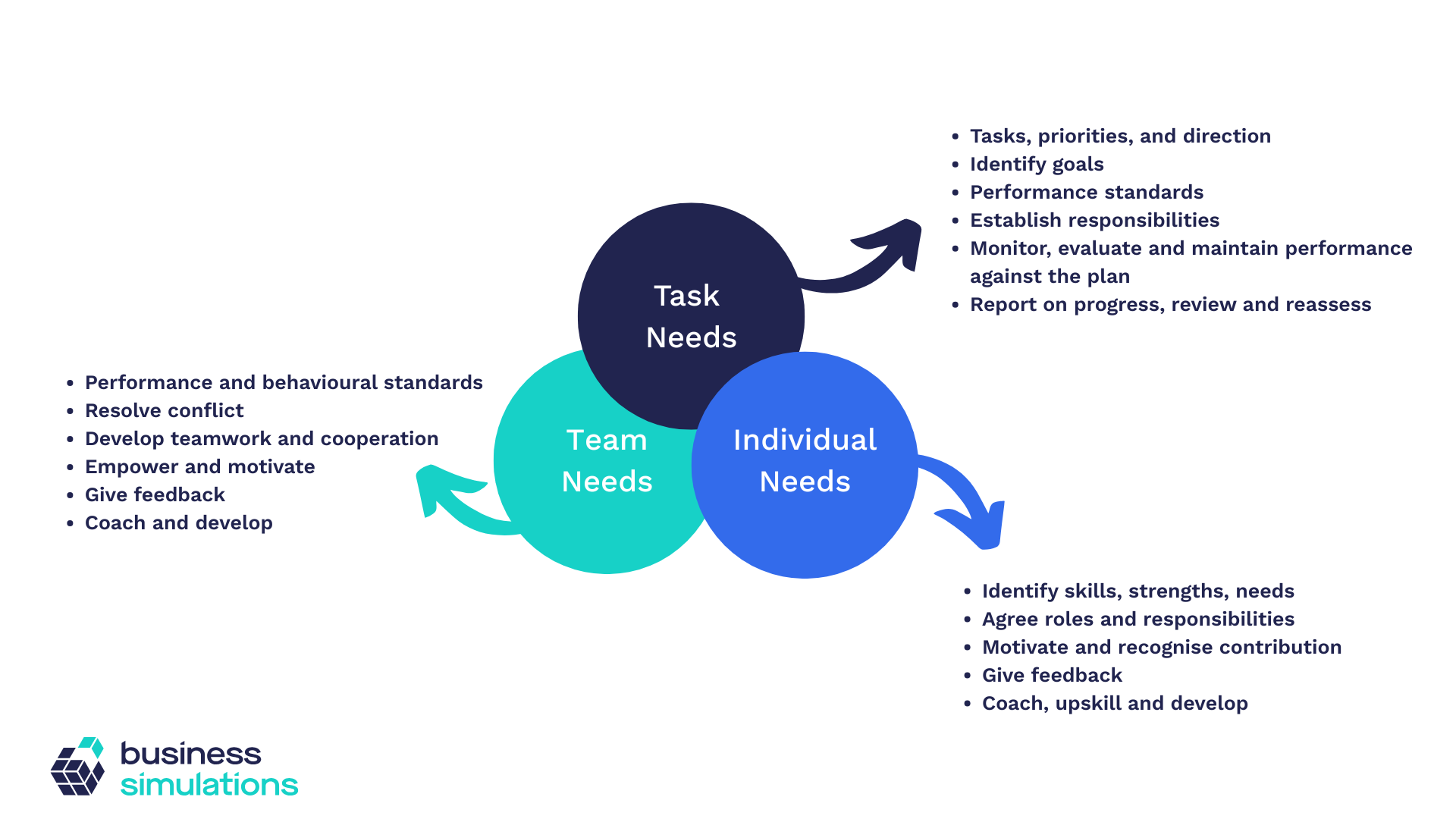Action-centred leadership; leading a team effectively
By Kieleigh Dixon, Aug 15, 2022 Last updated Sep 23, 2025
I wonder if you’ve ever had the unforgettable experience of being led by a new manager who has neither managed people before nor been given any training in “soft skills”? Being managed in this way is rarely a good experience – however, it is amazing just how often it seems to happen in busy organisations!
Bad as it was for you, it was probably not a great experience for the new manager either. Transitioning to a new leadership role, where you are suddenly thrown into managing a team, can be daunting. For many new leaders, the move from managing self to managing others often comes with a lack of clarity, uncertainty, and doubt around what it actually takes to succeed.
The good news is that it doesn’t need to be like this!
In fact, a great leadership model to help with this is John Adair’s action-centred leadership (ACL) model. In this article, we look at how ACL can be combined with an appropriate business simulation – for example, Crew – to allow new managers to quickly hit the ground running in terms of their people and team leadership skills.
What is action-centred leadership?
Developed in the 1960s by one of the world’s leading authorities on leadership, John Adair, action-centred leadership is equally relevant today. ACL provides a great blueprint for any new team leader by highlighting three key areas and the actions that leaders need to focus on to successfully manage their team. The three core areas are: task needs, team needs and individual needs.

Task needs
- Tasks, priorities, vision and direction
- Identify goals
- Set performance standards
- Establish responsibilities
- Monitor, evaluate and maintain performance against the plan
- Report on progress, review and reassess
Team needs
- Performance and behavioural standards
- Resolve conflict
- Develop teamwork and cooperation
- Empower and motivate
- Give feedback
- Coach and develop
Individual needs
- Identify skills, strengths, needs
- Agree roles and responsibilities
- Motivate and recognise contribution
- Give feedback
- Coach, upskill and develop
The interlocking areas of the circles show that each relies on one or both of the others for success. To be an effective leader of others, you must balance all three areas of responsibility.
Examples of imbalance
Example 1
Your manager has put intense pressure on you to hit your department goals or service level agreements.
If, based on this scenario, you decided to prioritise the task at the expense of the team and the individuals (who are working hard to achieve it), problems can arise. You may have little time for your team, which can result in conflicts, incomplete work and a negative impact on morale. Individuals may feel ignored, affecting their wellbeing, motivation and productivity.
Example 2
Let’s say that your team works well together, but one team member is falling behind (possibly due to a capability issue).
If this is left unaddressed, productivity may decline, or deadlines may be missed, impacting group morale. In this case, the unaddressed individual issue negatively impacts both the task and the team.
Example 3
Imagine you have a highly skilled team that collaborates well. You meet regularly and ensure they have the necessary skills. However, as a leader, you haven’t clearly stated your team’s vision or goals.
The result? Slow progress, because no one knows what they're aiming for. In this example, individual and team needs are being met, but the task itself is being ignored – which leads to failure.
Things to consider
There are several ways to fulfil each area of responsibility. Use the following lists as a guide and adapt based on your own circumstances.
Achieving the task
- Define your team's tasks, priorities, vision, purpose, direction and goals, and communicate them clearly
- Define success – include the team’s views
- Identify and allocate resources
- Create a plan with deliverables, measures, timescales, strategy and tactics
- Agree on responsibilities, objectives, accountabilities and measures
- Stay aware of internal and external factors and adapt quickly
- Set standards for quality, time and reporting; maintain activities
- Prioritise based on task importance and complexity
- Monitor, evaluate and maintain performance
- Report progress towards the team's aim
- Review, reassess and adjust plans as needed
Focusing on the team
- Agree and communicate performance and behaviour standards
- Ensure skills, training and ability are in place
- Monitor and maintain relationships
- Anticipate and resolve conflict
- Adjust team balance and composition as needed
- Make people feel valued
- Foster teamwork, cooperation and team spirit
- Build the team’s maturity and capability; increase autonomy
- Motivate with a shared purpose and support
- Identify and develop team and project leadership roles
- Give and receive team feedback
Focusing on the individual
- Understand individual strengths, needs, aims and concerns
- Define clear roles and tasks
- Support development with coaching and planning
- Set and agree individual responsibilities and objectives
- Acknowledge and reward effort and contribution
- Encourage high performers and play to strengths
- Identify and use each individual's capabilities
- Provide regular feedback
- Offer training and development
- Promote autonomy
Adopting the ACL model in practice
So, you like the sound of ACL – but how do you adopt it?
The best way we’ve found is for new managers to learn ACL experientially through a business simulation or leadership scenario.
For example, Crew is our team leader simulation that allows teams to practise all three elements of the action-centred leadership model in a safe, risk-free environment.
Each round, the team collectively acts as the operational team leader, managing and balancing all the issues arising in task, team and individual categories.
Crew requires the team leader to schedule themselves and their five simulation team members to appropriate work projects over an intense four-week period, while managing personal, skills, attitude and team issues as they arise.
Crew powerfully demonstrates a key leadership lesson that derails many new managers because it’s counter-intuitive:
“If you focus too much on the work scheduling and project tasks but neglect the team and individual issues, your productivity will soon degrade, damaging your project delivery performance.”
If you would like more information on our Crew business simulation, please get in touch using the form below.
